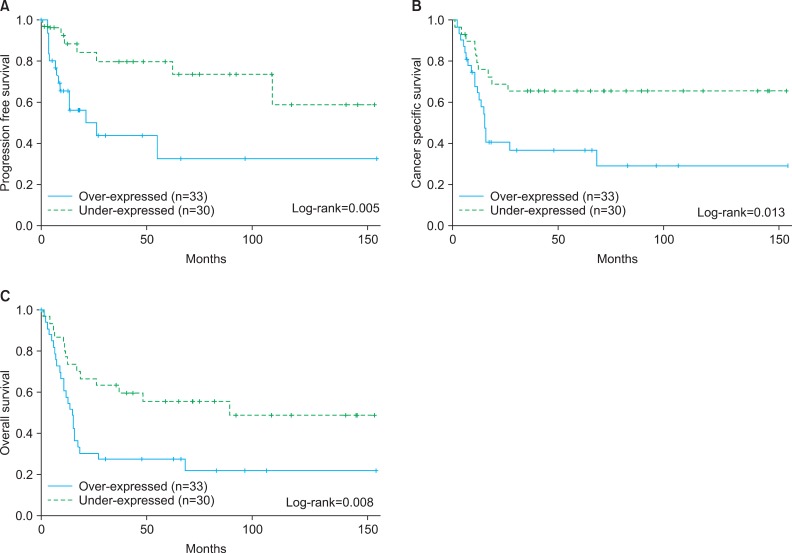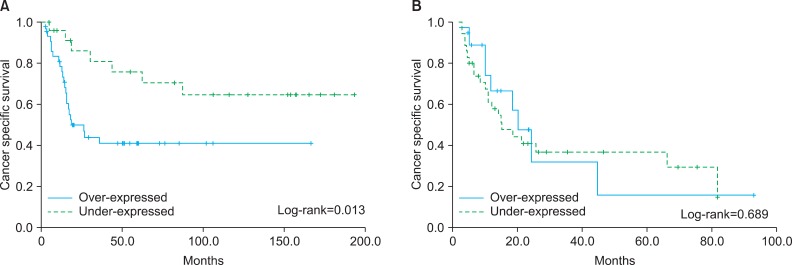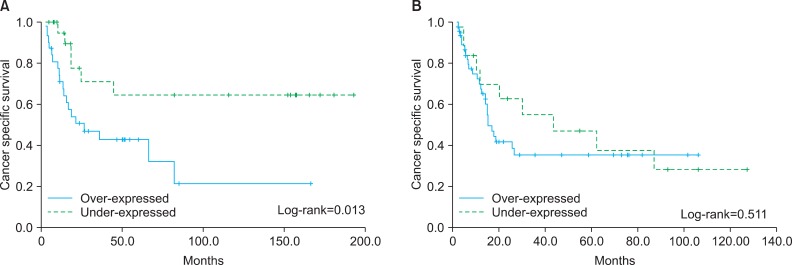Korean J Urol.
2012 Sep;53(9):598-606. 10.4111/kju.2012.53.9.598.
FAM70B as a Novel Prognostic Marker for Cancer Progression and Cancer-Specific Death in Muscle-Invasive Bladder Cancer
- Affiliations
-
- 1Department of Urology, Chungbuk National University College of Medicine, Cheongju, Korea. sjyun@chungbuk.ac.kr
- 2Section of Urologic Oncology, The Cancer Institute of New Jersey, Robert Wood Johnson Medical School, New Brunswick, NJ, USA.
- KMID: 2061697
- DOI: http://doi.org/10.4111/kju.2012.53.9.598
Abstract
- PURPOSE
To validate whether FAM70B, which was found in our micro-array profiling as a prognostic marker for cancer survival, could accurately predict prognosis in patients with muscle-invasive bladder cancer (MIBC).
MATERIALS AND METHODS
A total of 124 patients with MIBC were enrolled in this study. The FAM70B expression level was analyzed by real-time polymerase chain reaction by using RNA from tumor tissues. The prognostic effect of FAM70B was evaluated by Kaplan-Meier analysis and a multivariate Cox regression model.
RESULTS
Kaplan-Meier estimates showed a significant difference in progression-free survival (log-rank test, p=0.011) and cancer-specific survival (log-rank test, p=0.017) according to FAM70B gene expression level. By multivariate Cox regression analysis, high FAM70B expression was predictive of cancer progression (hazard ratio [HR], 2.115, p=0.013) and cancer-specific death (HR, 1.925; p=0.033). In the subgroup analysis, high expression of FAM70B was associated with poor cancer-specific survival, progression-free survival, and overall survival in the patients who underwent cystectomy (log-rank test, p=0.013, p=0.036, p=0.005, respectively). In the chemotherapy group, FAM70B expression was associated with cancer-specific survival and progression-free survival (log-rank test, p=0.013, p=0.042, respectively). Moreover, high FAM70B expression was associated with shorter cancer-specific survival in localized or locally advanced tumor stages (log-rank test, p=0.016).
CONCLUSIONS
We confirmed the significance of FAM70B as a prognostic marker in a validation cohort. Therefore, we propose that the FAM70B gene could be used to more precisely predict cancer progression and cancer-specific death in patients with MIBC.
MeSH Terms
Figure
Reference
-
1. Siegel R, Naishadham D, Jemal A. Cancer statistics, 2012. CA Cancer J Clin. 2012; 62:10–29. PMID: 22237781.
Article2. Jung KW, Park S, Kong HJ, Won YJ, Lee JY, Seo HG, et al. Cancer statistics in Korea: incidence, mortality, survival, and prevalence in 2009. Cancer Res Treat. 2012; 44:11–24. PMID: 22500156.
Article3. Ha YS, Kim MJ, Yoon HY, Kang HW, Kim YJ, Yun SJ, et al. mRNA Expression of S100A8 as a prognostic marker for progression of non-muscle-invasive bladder cancer. Korean J Urol. 2010; 51:15–20. PMID: 20414404.
Article4. Babjuk M, Oosterlinck W, Sylvester R, Kaasinen E, Bohle A, Palou-Redorta J, et al. EAU guidelines on non-muscle-invasive urothelial carcinoma of the bladder. Eur Urol. 2008; 54:303–314. PMID: 18468779.
Article5. Kaufman DS, Shipley WU, Feldman AS. Bladder cancer. Lancet. 2009; 374:239–249. PMID: 19520422.
Article6. Parkin DM, Bray F, Ferlay J, Pisani P. Global cancer statistics, 2002. CA Cancer J Clin. 2005; 55:74–108. PMID: 15761078.
Article7. Kim WJ, Kim EJ, Kim SK, Kim YJ, Ha YS, Jeong P, et al. Predictive value of progression-related gene classifier in primary non-muscle invasive bladder cancer. Mol Cancer. 2010; 9:3. PMID: 20059769.
Article8. Kim YK, Kim WJ. Epigenetic markers as promising prognosticators for bladder cancer. Int J Urol. 2009; 16:17–22. PMID: 18721202.
Article9. Habuchi T, Marberger M, Droller MJ, Hemstreet GP 3rd, Grossman HB, Schalken JA, et al. Prognostic markers for bladder cancer: International Consensus Panel on bladder tumor markers. Urology. 2005; 66(6 Suppl 1):64–74. PMID: 16399416.
Article10. Dyrskjøt L, Zieger K, Real FX, Malats N, Carrato A, Hurst C, et al. Gene expression signatures predict outcome in non-muscle-invasive bladder carcinoma: a multicenter validation study. Clin Cancer Res. 2007; 13:3545–3551. PMID: 17575217.
Article11. Takata R, Katagiri T, Kanehira M, Tsunoda T, Shuin T, Miki T, et al. Predicting response to methotrexate, vinblastine, doxorubicin, and cisplatin neoadjuvant chemotherapy for bladder cancers through genome-wide gene expression profiling. Clin Cancer Res. 2005; 11:2625–2636. PMID: 15814643.
Article12. Eschrich S, Yang I, Bloom G, Kwong KY, Boulware D, Cantor A, et al. Molecular staging for survival prediction of colorectal cancer patients. J Clin Oncol. 2005; 23:3526–3535. PMID: 15908663.
Article13. Kim WJ, Kim SK, Jeong P, Yun SJ, Cho IC, Kim IY, et al. A four-gene signature predicts disease progression in muscle invasive bladder cancer. Mol Med. 2011; 17:478–485. PMID: 21308147.
Article14. Kim SK, Kim EJ, Leem SH, Ha YS, Kim YJ, Kim WJ. Identification of S100A8-correlated genes for prediction of disease progression in non-muscle invasive bladder cancer. BMC Cancer. 2010; 10:21. PMID: 20096140.
Article15. Kim YJ, Ha YS, Kim SK, Yoon HY, Lym MS, Kim MJ, et al. Gene signatures for the prediction of response to Bacillus Calmette-Guerin immunotherapy in primary pT1 bladder cancers. Clin Cancer Res. 2010; 16:2131–2137. PMID: 20233890.16. Greene FL. The American Joint Committee on Cancer: updating the strategies in cancer staging. Bull Am Coll Surg. 2002; 87:13–15. PMID: 17387902.17. Stenzl A, Cowan NC, De Santis M, Jakse G, Kuczyk MA, Merseburger AS, et al. The updated EAU guidelines on muscle-invasive and metastatic bladder cancer. Eur Urol. 2009; 55:815–825. PMID: 19157687.
Article18. Catto JW, Azzouzi AR, Rehman I, Feeley KM, Cross SS, Amira N, et al. Promoter hypermethylation is associated with tumor location, stage, and subsequent progression in transitional cell carcinoma. J Clin Oncol. 2005; 23:2903–2910. PMID: 15753461.
Article19. Weinstein JN, Scherf U, Lee JK, Nishizuka S, Gwadry F, Bussey AK, et al. The bioinformatics of microarray gene expression profiling. Cytometry. 2002; 47:46–49. PMID: 11774349.
Article20. Dyrskjot L, Kruhoffer M, Thykjaer T, Marcussen N, Jensen JL, Moller K, et al. Gene expression in the urinary bladder: a common carcinoma in situ gene expression signature exists disregarding histopathological classification. Cancer Res. 2004; 64:4040–4048. PMID: 15173019.21. Zhang Z, Karam J, Frenkel E, Sagalowsky A, Hsieh JT. The application of epigenetic modifiers on the treatment of prostate and bladder cancer. Urol Oncol. 2006; 24:152–160. PMID: 16520279.
Article22. Chen HY, Yu SL, Chen CH, Chang GC, Chen CY, Yuan A, et al. A five-gene signature and clinical outcome in non-small-cell lung cancer. N Engl J Med. 2007; 356:11–20. PMID: 17202451.
Article23. Lossos IS, Czerwinski DK, Alizadeh AA, Wechser MA, Tibshirani R, Botstein D, et al. Prediction of survival in diffuse large-B-cell lymphoma based on the expression of six genes. N Engl J Med. 2004; 350:1828–1837. PMID: 15115829.
Article24. van de Vijver MJ, He YD, van't Veer LJ, Dai H, Hart AA, Voskuil DW, et al. A gene-expression signature as a predictor of survival in breast cancer. N Engl J Med. 2002; 347:1999–2009. PMID: 12490681.
Article25. Beer DG, Kardia SL, Huang CC, Giordano TJ, Levin AM, Misek DE, et al. Gene-expression profiles predict survival of patients with lung adenocarcinoma. Nat Med. 2002; 8:816–824. PMID: 12118244.
Article26. Alizadeh AA, Eisen MB, Davis RE, Ma C, Lossos IS, Rosenwald A, et al. Distinct types of diffuse large B-cell lymphoma identified by gene expression profiling. Nature. 2000; 403:503–511. PMID: 10676951.
Article27. Dyrskjot L, Thykjaer T, Kruhoffer M, Jensen JL, Marcussen N, Hamilton-Dutoit S, et al. Identifying distinct classes of bladder carcinoma using microarrays. Nat Genet. 2003; 33:90–96. PMID: 12469123.
Article28. Gerhard DS, Wagner L, Feingold EA, Shenmen CM, Grouse LH, Schuler G, et al. The status, quality, and expansion of the NIH full-length cDNA project: the Mammalian Gene Collection (MGC). Genome Res. 2004; 14(10B):2121–2127. PMID: 15489334.29. Dunham A, Matthews LH, Burton J, Ashurst JL, Howe KL, Ashcroft KJ, et al. The DNA sequence and analysis of human chromosome 13. Nature. 2004; 428:522–528. PMID: 15057823.
- Full Text Links
- Actions
-
Cited
- CITED
-
- Close
- Share
- Similar articles
-
- Autophagy and urothelial carcinoma of the bladder: A review
- Clinical Prognostic Factors for Radical Cystectomy in Bladder Cancer
- Accuracy of Vesical Imaging-Reporting and Data System for muscle-invasive bladder cancer detection from multiparametric magnetic resonance imaging
- Can we use methylation markers as diagnostic and prognostic indicators for bladder cancer?
- Predictive Value of Urinary Cytology in the Recurrence and the Progression of Superficial Bladder Cancer






